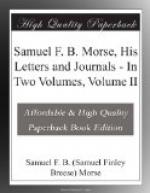As iron tubing would not have answered Morse’s purpose, this decorous solicitation was declined with thanks.
During the first few months everything worked smoothly, and the prospect of an early completion of the line was bright. Morse kept all his accounts in the most businesslike manner, and his monthly accounts to the Secretary of the Treasury were models of accuracy and a conscientious regard for the public interest.
One small cloud appeared above the horizon, so small that the unsuspecting inventor hardly noticed it, and yet it was destined to develop into a storm of portentous dimensions. On May 17, he wrote to F.O.J. Smith from New York:—
“Yours of the 27th April I have this morning received enclosing the contracts for trenching. I have examined the contract and I must say I am not exactly pleased with the terms. If I understood you right, before you left for Boston, you were confident a contract could be made far within the estimates given in to the Government, and I had hoped that something could be saved from that estimate as from the others, so as to present the experiment before the country in as cheap a form as possible.
“I have taken a pride in showing to Government how cheaply the Telegraph could be laid, since the main objection, and the one most likely to defeat our ulterior plans, is its great expense. I have in my other contracts been able to be far within my estimates to Government, and I had hoped to be able to present to the Secretary the contract for trenching likewise reduced. There are plenty of applicants here who will do it for much less, and one even said he thought for one half. I shall do nothing in regard to the matter until I see you.”
A great personal sorrow came to him also, a short time after this, to dim the brilliance of success. On July 9, 1843, his dearly loved friend and master, Washington Allston, died in Boston after months of suffering. Morse immediately dropped everything and hastened to Boston to pay the last tributes of respect to him whom he regarded as his best friend. He obtained as a memento one of the brushes, still wet with paint, which Allston was using on his last unfinished work, “The Feast of Belshazzar,” when he was suddenly stricken. This brush he afterwards presented to the National Academy of Design, where it is, I believe, still preserved.
Sorrowfully he returned to his work in Washington, but with the comforting thought that his friend had lived to see his triumph, the justification for his deserting that art which had been the bond to first bring them together.
On July 24, in his report to the Secretary of the Treasury, he says:—
“I have also the gratification to report that the contract for the wire has been faithfully fulfilled on the part of Aaron Benedict, the contractor; that the first covering with cotton and two varnishings of the whole one hundred and sixty miles is also completed; that experiments made upon forty-three miles have resulted in the most satisfactory manner, and that the whole work is proceeding with every prospect of a successful issue.”




